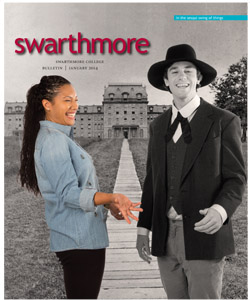Early leaders strongly tied to Underground Railroad
The stately oaks that usher the traveler from the Swarthmore train station to the College’s hilltop hub were planted in 1879 by a veteran of another kind of railroad—a network to assist fugitive slaves with no clearly marked route.
Edward Magill, Swarthmore’s second president, grew up north of Philadelphia in Bucks County. In his youth, he transported escaped slaves by wagon from Solebury to New Hope, Pa., on the Delaware River. After his retirement from the College, he recorded the many stories of his early friends and neighbors who were also involved with the Underground Railroad.
Though Swarthmore did not hold its first classes until 1869, the College had many supporters who had held strong anti-slavery views, some of whom were participants in the escaped-slave network. Westdale, as the Swarthmore area was first called, was located only 18 miles from the slave state of Delaware and part of the first hospitable ground encountered by slaves who fled before the Civil War.
Quakers had been voicing objections to the institution of slavery since before the Revolutionary War. In fact, the grandfather of Edward Parrish, Swarthmore’s first president, originally joined the Pennsylvania Abolition Society in 1784, followed by Edward’s father Joseph and then Edward himself in 1848. Edward’s childhood home in Philadelphia served as a station on the Underground Railroad, and he and his siblings “learned to keep quiet when a slave was harbored in the cellar,” as reported in the Friends’ Intelligencer in 1915.
At the insistence of the College founders, a portrait of Isaac Hopper hangs in the west front parlor in Parrish. A leading member of the Pennsylvania Abolition Society, Hopper spent his life aiding fugitive slaves and has been described as the founder of the Underground Railroad. Frederick Douglass, the renowned African-American social reformer, questioned his own “well-established conviction” that no white man could have true respect for the black man after hearing Hopper’s courtroom defense of an escaped slave.
In his 1872 memoir The Underground Railroad, William Still, who helped about 800 slaves gain freedom, listed many College-related families among those who helped the anti-slavery cause. The names sound like an inventory of campus buildings, including Clothier, Wharton, Hallowell, and Parrish.
Still also mentions Lucretia Coffin Mott, a Quaker social activist, founder of the Female Anti-Slavery Society in Philadelphia in 1833, and a primary organizer of the seminal 1848 Seneca Falls women’s rights conference. Subsequently, she became one of the founders of the College. Now, 150 years later, her life and legacy provide enduring inspiration to Rebecca Chopp, Swarthmore’s 14th president.
Based on 2013 Garnet Weekend walking tour, “Quakers, Swarthmore, and The Underground Railroad,” given by Friends Historical Library Curator Christopher Densmore.
 Email This Page
Email This Page